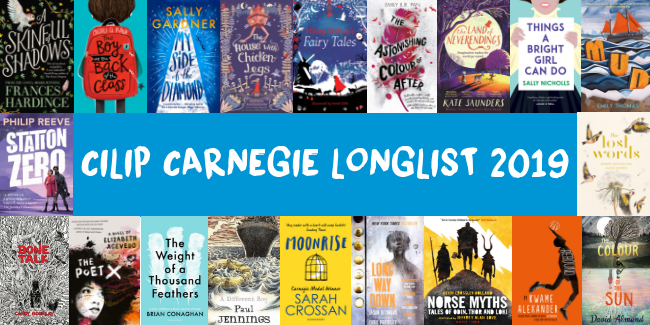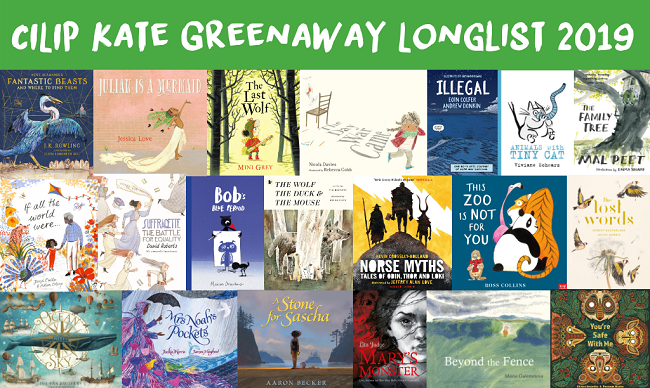For help, advice and telephone ordering call our team on 0121 666 6646
Are you sure you wish to delete this basket?()
This action cannot be undone.
Sorry, something went wrong
Please report the problem here.
Chair of CILIP judges Alison Brumwell discusses the 2019 Carnegie and Kate Greenaway longlists

February 19th 2019
Chair of CILIP judges Alison Brumwell discusses the 2019 Carnegie and Kate Greenaway longlists
Chairing the CILIP Carnegie and Kate Greenaway Medals in 2019 has been both challenging and rewarding. In addition to a new record total of 254 nominated titles, the oldest children’s book awards in the UK also began implementing the recommendations made in the Diversity Review report, published in September 2018. Our commitment to ensuring that the medals celebrate excellence in writing and illustration for young people goes hand-in-hand with visibly embedding diversity in all our processes. I am immensely proud of the panel of 14 volunteer librarian judges who are giving their time, critical expertise and lived experience to guarantee that a remarkable legacy remains current and vibrant. This is even more important during a year which commemorates the 30th anniversary of the Convention on the Rights of the Child. A child’s right to read is fundamental, and one which the Carnegie and Kate Greenaway Medals wholeheartedly embrace.
The 2019 longlists feature wonderful new voices from the UK and around the world, including works in translation, alongside some past Carnegie and Kate Greenaway Medal winners and familiar names . The difficulty of whittling each longlist down to only 20 titles is testament to a thriving UK children’s publishing industry and the growth of smaller, independent presses. I invite you to imagine a drum roll as I introduce the books we decided were the very best of a banner year for children’s and young adult writing and illustration.
The CILIP Carnegie Medal
 The 2019 CILIP Carnegie Medal longlist celebrates some of the finest contemporary writing with a wide range of styles, genres and forms; including, fiction, verse novels, poetry, novellas and short stories.
Complex families and related issues feature prominently in Brian Conaghan’s moving novel, The Weight of a Thousand Feathers, an unflinching account of the lives of two young carers whose mother is terminally-ill, told with tenderness and black humour; while Sarah Crossan’s profoundly moving verse novel, Moonrise, gives the reader a searing look at the heartbreak teenaged Joe faces when he visits his older brother on death row after ten years apart. And David Almond, whose Skellig won the Carnegie Medal in 1998, brings his glorious and evocative prose style to The Colour of the Sun, a hot, lingering summer day in the life of Davie where the imaginary is just as powerful as the real.
Two imaginative, accomplished UK debut novels stand out in this year’s Carnegie Medal longlist, both of which deal with growing up and coping with loss. Sophie Anderson’s The House with Chicken Legs is a thoughtful reinvention of the Baba Yaga legend, in which Marinka learns about life and letting go on her travels with the most wonderfully realised House. The challenges of a blended family and the consequences of a bereavement are at the heart of Emily Thomas’ Mud, in which she deftly explores the trials of life on a boat with an unstable, alcoholic father through the honest and thoroughly engaging perspective of Lydia.
The science fiction genre also features on the 2019 Carnegie Medal longlist. Previous Carnegie Medal winner, Philip Reeve concludes his Railhead trilogy with Station Zero, again executing superb world-building with an exploration of the very real issues of immigration, gender and what it means to be human, as thrill-seeking Zen Starling embarks once again on an intergalactic journey. Sally Gardner’s My Side of the Diamond also uses science fiction conventions to probe similar issues in this taut, inventively-structured narrative, which unfolds as a series of interviews in an intricate puzzle of a book.
Myths and fairy tales are brought up-to-date in Kevin Crossley-Holland’s Norse Myths and Hilary McKay’s Fairy Tales. Each myth and fairy tale in these expertly-curated collections has its own perfect narrative arc, in which familiar characters like Loki and Rumpelstiltskin are re-visited with a fresh perspective. Themes of family, loss, greed and transformation are explored with insight by these two master storytellers.
Kate Saunders’ moving novel The Land of Neverendings was recognised for its well-integrated elements of fairy tale and fantasy, in a carefully-crafted novel for all generations about universal themes of loss, family and reconciliation. Judges were also impressed by the world-building of Smockeroon and brilliant characterisation of Hugo, Smiffy and the dark genius of Prison Wendy.
Gritty, urban realism is at the fore in three outstanding verse novels from US writers. In Rebound Kwame Alexander gives us Charlie Bell’s coming-of-age during the hottest ever Washington DC summer. Redolent with basketball references, rhythm and Grandpappy’s jazz riffs, this is a remarkable verse novel and a moving account of dealing with loss and bestowing a legacy. Jason Reynolds’ Long Way Down takes the reader on an agonising elevator descent, from the seventh floor down to the lobby. We read Will’s rules, understand his reasons and survival tactics and feel his grief. We are with him all the way, as we are with the astonishing Xiomara in Elizabeth Acevedo’s debut novel The Poet X, a Dominican poetic narrative written by a powerful young Dominica voice, full of pride and infused with the essence of Harlem.
Emily X.R. Pan’s debut novel The Astonishing Colour of After was praised by judges for its lyrical style and moving exploration of grief, loss and fractured identity. Magic realism is fused beautifully with central character Leigh’s exploration of her Taiwanese heritage following her mother’s suicide.
Historical novels with a twist feature on the Carnegie longlist in Frances Hardinge’s A Skinful of Shadows and Candy Gourlay’s Bone Talk. The spirit world moves effectively through each narrative; in Makepeace’s courageous defence of her own liberty, a tour-de-force narrative tapestry by Hardinge. It’s visible also in Gourlay’s brilliant novel during which two worlds collide as Samkad journeys to manhood during the American invasion of the Philippines at the end of the 19th century.
First World War narratives have recently been abundant, but this year’s judges recognised Sally Nicholls’ Things a Bright Girl Can Do for its expert inter-weaving of three separate narrative voices and its powerful insights upon issues related to women’s suffrage, poverty and sexual identity.
Themes of language, displacement and migration round out this year’s Carnegie Medal longlisted titles. Onjali Q. Rauf’s novel The Boy at the Back of the Class depicts with insight and empathy the plight of a young refugee and the attempts his classmates make to help him integrate and locate his missing family. The motif of a pomegranate is prominent and can also be used to represent well-known Australian author Paul Jennings’ A Different Boy. This perfect jewel of a novella explores loss, isolation and the difficult migrant experience with spare, eloquent prose.
Finally, Robert Macfarlane’s outstanding poetry collection, The Lost Words, was selected by judges for this year’s Carnegie Medal longlist due to its well-crafted celebration of language and the natural world. Each poem is integral to the collection and is written in a distinctive voice which is full of wonder.
The CILIP Kate Greenaway Medal
The 2019 CILIP Carnegie Medal longlist celebrates some of the finest contemporary writing with a wide range of styles, genres and forms; including, fiction, verse novels, poetry, novellas and short stories.
Complex families and related issues feature prominently in Brian Conaghan’s moving novel, The Weight of a Thousand Feathers, an unflinching account of the lives of two young carers whose mother is terminally-ill, told with tenderness and black humour; while Sarah Crossan’s profoundly moving verse novel, Moonrise, gives the reader a searing look at the heartbreak teenaged Joe faces when he visits his older brother on death row after ten years apart. And David Almond, whose Skellig won the Carnegie Medal in 1998, brings his glorious and evocative prose style to The Colour of the Sun, a hot, lingering summer day in the life of Davie where the imaginary is just as powerful as the real.
Two imaginative, accomplished UK debut novels stand out in this year’s Carnegie Medal longlist, both of which deal with growing up and coping with loss. Sophie Anderson’s The House with Chicken Legs is a thoughtful reinvention of the Baba Yaga legend, in which Marinka learns about life and letting go on her travels with the most wonderfully realised House. The challenges of a blended family and the consequences of a bereavement are at the heart of Emily Thomas’ Mud, in which she deftly explores the trials of life on a boat with an unstable, alcoholic father through the honest and thoroughly engaging perspective of Lydia.
The science fiction genre also features on the 2019 Carnegie Medal longlist. Previous Carnegie Medal winner, Philip Reeve concludes his Railhead trilogy with Station Zero, again executing superb world-building with an exploration of the very real issues of immigration, gender and what it means to be human, as thrill-seeking Zen Starling embarks once again on an intergalactic journey. Sally Gardner’s My Side of the Diamond also uses science fiction conventions to probe similar issues in this taut, inventively-structured narrative, which unfolds as a series of interviews in an intricate puzzle of a book.
Myths and fairy tales are brought up-to-date in Kevin Crossley-Holland’s Norse Myths and Hilary McKay’s Fairy Tales. Each myth and fairy tale in these expertly-curated collections has its own perfect narrative arc, in which familiar characters like Loki and Rumpelstiltskin are re-visited with a fresh perspective. Themes of family, loss, greed and transformation are explored with insight by these two master storytellers.
Kate Saunders’ moving novel The Land of Neverendings was recognised for its well-integrated elements of fairy tale and fantasy, in a carefully-crafted novel for all generations about universal themes of loss, family and reconciliation. Judges were also impressed by the world-building of Smockeroon and brilliant characterisation of Hugo, Smiffy and the dark genius of Prison Wendy.
Gritty, urban realism is at the fore in three outstanding verse novels from US writers. In Rebound Kwame Alexander gives us Charlie Bell’s coming-of-age during the hottest ever Washington DC summer. Redolent with basketball references, rhythm and Grandpappy’s jazz riffs, this is a remarkable verse novel and a moving account of dealing with loss and bestowing a legacy. Jason Reynolds’ Long Way Down takes the reader on an agonising elevator descent, from the seventh floor down to the lobby. We read Will’s rules, understand his reasons and survival tactics and feel his grief. We are with him all the way, as we are with the astonishing Xiomara in Elizabeth Acevedo’s debut novel The Poet X, a Dominican poetic narrative written by a powerful young Dominica voice, full of pride and infused with the essence of Harlem.
Emily X.R. Pan’s debut novel The Astonishing Colour of After was praised by judges for its lyrical style and moving exploration of grief, loss and fractured identity. Magic realism is fused beautifully with central character Leigh’s exploration of her Taiwanese heritage following her mother’s suicide.
Historical novels with a twist feature on the Carnegie longlist in Frances Hardinge’s A Skinful of Shadows and Candy Gourlay’s Bone Talk. The spirit world moves effectively through each narrative; in Makepeace’s courageous defence of her own liberty, a tour-de-force narrative tapestry by Hardinge. It’s visible also in Gourlay’s brilliant novel during which two worlds collide as Samkad journeys to manhood during the American invasion of the Philippines at the end of the 19th century.
First World War narratives have recently been abundant, but this year’s judges recognised Sally Nicholls’ Things a Bright Girl Can Do for its expert inter-weaving of three separate narrative voices and its powerful insights upon issues related to women’s suffrage, poverty and sexual identity.
Themes of language, displacement and migration round out this year’s Carnegie Medal longlisted titles. Onjali Q. Rauf’s novel The Boy at the Back of the Class depicts with insight and empathy the plight of a young refugee and the attempts his classmates make to help him integrate and locate his missing family. The motif of a pomegranate is prominent and can also be used to represent well-known Australian author Paul Jennings’ A Different Boy. This perfect jewel of a novella explores loss, isolation and the difficult migrant experience with spare, eloquent prose.
Finally, Robert Macfarlane’s outstanding poetry collection, The Lost Words, was selected by judges for this year’s Carnegie Medal longlist due to its well-crafted celebration of language and the natural world. Each poem is integral to the collection and is written in a distinctive voice which is full of wonder.
The CILIP Kate Greenaway Medal
 Stunning illustrated works abound on this year’s 2019 Kate Greenaway longlist, which includes books by artists from the UK, USA, Canada, Australia, Italy and Bulgaria. Acclaimed Canadian illustrator Jon Klassen, a past winner of both the Kate Greenaway and Caldecott Medals for This is Not My Hat, appears on the longlist for his visually witty collaboration with Mac Barnett in The Wolf, the Duck & the Mouse. Every Duck’s (and Mouse’s) home is his castle…but in this case, home is the bemused Wolf’s stomach. Klassen once again uses his unique style and colour palette to great effect in this whimsical picture book.
Norse Myths and The Lost Words are doubly honoured in 2019, appearing on both the Carnegie and Kate Greenaway Medal longlists, with Jeffrey Alan Love’s bold, distinctive roller-painted images lending scale and drama to tales of Odin, Thor and Loki and Jackie Morris’ gorgeous, detailed paintings enhancing the nature poetry of Robert Macfarlane. Jackie Morris also authors James Mayhew’s stunning Mrs. Noah’s Pockets, which was recognised in this year’s longlist for its use of vivid colour, visual flow and illustrative detail in the small block prints,
The vibrant use of colour and detail on covers and in double-paged spreads was particularly noted by judges in Eric and Terry Fan’s Ocean Meets Sky, Jessica Love’s debut picture book Julian is a Mermaid and Allison Colpoys’ distinctive If All the World Were… All three books celebrate diverse family life, the power of the imagination and positive older role models.
Ross Collins’ distinctive, effervescent style and playfulness is evident throughout This Zoo is Not for You, which addresses the themes of friendship and inclusion with a light touch. Mini Grey, past Kate Greenaway Medal winner in 2007, follows up last year’s The Bad Bunnies’ Magic Show with The Last Wolf. Her unique take on the fairy tale of Little Red Riding Hood was longlisted by 2019 judges for its visual humour, distinctive style and subtle message about the environment.
Animals abound in two imaginative and wildly different illustrated texts. The lavish detail and elegant use of hand-lettering and layout, including a spectacular triptych of the Ukrainian Ironbelly, makes Olivia Lomenech Gill’s Fantastic Beasts and Where to Find Them: Illustrated Edition a visual feast. Viviane Schwarz’ Animals with Tiny Cat is a compendium of a different order, with a striking use of limited colour and bold, sweeping black lines which bring Tiny Cat’s playful antics to life.
Displacement, loss and the plight of refugees are highlighted in Giovanni Rigano’s graphic novel Illegal and the effective, naïve illustrative style of Rebecca Cobb in The Day the War Came. While differing in inception and overall design they were both acclaimed for their use of perspective and innovative layout.
A more intimate sense of loss is evoked in Aaron Becker’s wordless picture book, A Stone for Sascha, set against a sweeping historical backdrop and awash in a golden glow which radiates like the marker for Sasha’s grave. Emma Shoard’s use of watercolour in swathes of subtle colours and black brush strokes work in perfect synergy with Mal Peet’s simple tale of a family unravelling due to depression in The Family Tree. And depression and friendship are beautifully explored in Marion Deuchars’ Bob’s Blue Period. Judges noted the use of colour and pattern, with different brush strokes, the use of hand lettering and bold black lines giving this picture book a distinctive feel.
Lita Judge’s Mary’s Monster is one of the several books published to coincide with the 200th anniversary of Mary Shelley’s Frankenstein. The monochrome illustrations which accompany each free-verse poem give life to the characters in Mary Shelley’s world and creative life, offering a vivid sense of place and a tenderness and warmth to the monster’s depiction.
David Roberts’ distinctive style and accomplished use of layout, framing and colour is perfectly suited to Suffragette, a detailed illustrated history of the movement which would change the 20th century. Judges also noted the meticulous use of small detail and a masterful use of scale in larger images.
And completing 2019’s stellar Kate Greenaway Medal longlist are two more debut picture books: Poonam Mistry’s You’re Safe with Me and Maria Gulemetova’s Beyond the Fence. You’re Safe with Me’s bold use of colour and geometric pattern are perfect for this gentle bedtime tale inspired by Indian folklore. Beyond the Fence is a celebration of identity, breaking free and friendship. There’s a wonderful contrast between the confines of the house in which Piggy lives and the sweep of the surrounding countryside. Fine detail used to delineate expression shows the range of emotion he experiences: boredom, frustration, hope and the elation of release.
It’s with elation and great pride that I invite you to explore these outstanding titles on the CILIP Carnegie and Kate Greenaway longlists.
Alison Brumwell
Chair of Judges, CILIP Carnegie and Kate Greenaway Medals 2019
The shortlists for the 2019 CILIP Carnegie and Kate Greenaway Medals will be announced on Tuesday 19th March 2019. The 2019 winners will be announced on 18th June 2019. For more information, visit www.carnegiegreenaway.org.uk.
Visit peters.co.uk/ckg to order your longlist sets with 35% off and free jacketing. You can also pre-order the shortlisted titles to receive them on Tuesday 19th March 2019.
Stunning illustrated works abound on this year’s 2019 Kate Greenaway longlist, which includes books by artists from the UK, USA, Canada, Australia, Italy and Bulgaria. Acclaimed Canadian illustrator Jon Klassen, a past winner of both the Kate Greenaway and Caldecott Medals for This is Not My Hat, appears on the longlist for his visually witty collaboration with Mac Barnett in The Wolf, the Duck & the Mouse. Every Duck’s (and Mouse’s) home is his castle…but in this case, home is the bemused Wolf’s stomach. Klassen once again uses his unique style and colour palette to great effect in this whimsical picture book.
Norse Myths and The Lost Words are doubly honoured in 2019, appearing on both the Carnegie and Kate Greenaway Medal longlists, with Jeffrey Alan Love’s bold, distinctive roller-painted images lending scale and drama to tales of Odin, Thor and Loki and Jackie Morris’ gorgeous, detailed paintings enhancing the nature poetry of Robert Macfarlane. Jackie Morris also authors James Mayhew’s stunning Mrs. Noah’s Pockets, which was recognised in this year’s longlist for its use of vivid colour, visual flow and illustrative detail in the small block prints,
The vibrant use of colour and detail on covers and in double-paged spreads was particularly noted by judges in Eric and Terry Fan’s Ocean Meets Sky, Jessica Love’s debut picture book Julian is a Mermaid and Allison Colpoys’ distinctive If All the World Were… All three books celebrate diverse family life, the power of the imagination and positive older role models.
Ross Collins’ distinctive, effervescent style and playfulness is evident throughout This Zoo is Not for You, which addresses the themes of friendship and inclusion with a light touch. Mini Grey, past Kate Greenaway Medal winner in 2007, follows up last year’s The Bad Bunnies’ Magic Show with The Last Wolf. Her unique take on the fairy tale of Little Red Riding Hood was longlisted by 2019 judges for its visual humour, distinctive style and subtle message about the environment.
Animals abound in two imaginative and wildly different illustrated texts. The lavish detail and elegant use of hand-lettering and layout, including a spectacular triptych of the Ukrainian Ironbelly, makes Olivia Lomenech Gill’s Fantastic Beasts and Where to Find Them: Illustrated Edition a visual feast. Viviane Schwarz’ Animals with Tiny Cat is a compendium of a different order, with a striking use of limited colour and bold, sweeping black lines which bring Tiny Cat’s playful antics to life.
Displacement, loss and the plight of refugees are highlighted in Giovanni Rigano’s graphic novel Illegal and the effective, naïve illustrative style of Rebecca Cobb in The Day the War Came. While differing in inception and overall design they were both acclaimed for their use of perspective and innovative layout.
A more intimate sense of loss is evoked in Aaron Becker’s wordless picture book, A Stone for Sascha, set against a sweeping historical backdrop and awash in a golden glow which radiates like the marker for Sasha’s grave. Emma Shoard’s use of watercolour in swathes of subtle colours and black brush strokes work in perfect synergy with Mal Peet’s simple tale of a family unravelling due to depression in The Family Tree. And depression and friendship are beautifully explored in Marion Deuchars’ Bob’s Blue Period. Judges noted the use of colour and pattern, with different brush strokes, the use of hand lettering and bold black lines giving this picture book a distinctive feel.
Lita Judge’s Mary’s Monster is one of the several books published to coincide with the 200th anniversary of Mary Shelley’s Frankenstein. The monochrome illustrations which accompany each free-verse poem give life to the characters in Mary Shelley’s world and creative life, offering a vivid sense of place and a tenderness and warmth to the monster’s depiction.
David Roberts’ distinctive style and accomplished use of layout, framing and colour is perfectly suited to Suffragette, a detailed illustrated history of the movement which would change the 20th century. Judges also noted the meticulous use of small detail and a masterful use of scale in larger images.
And completing 2019’s stellar Kate Greenaway Medal longlist are two more debut picture books: Poonam Mistry’s You’re Safe with Me and Maria Gulemetova’s Beyond the Fence. You’re Safe with Me’s bold use of colour and geometric pattern are perfect for this gentle bedtime tale inspired by Indian folklore. Beyond the Fence is a celebration of identity, breaking free and friendship. There’s a wonderful contrast between the confines of the house in which Piggy lives and the sweep of the surrounding countryside. Fine detail used to delineate expression shows the range of emotion he experiences: boredom, frustration, hope and the elation of release.
It’s with elation and great pride that I invite you to explore these outstanding titles on the CILIP Carnegie and Kate Greenaway longlists.
Alison Brumwell
Chair of Judges, CILIP Carnegie and Kate Greenaway Medals 2019
The shortlists for the 2019 CILIP Carnegie and Kate Greenaway Medals will be announced on Tuesday 19th March 2019. The 2019 winners will be announced on 18th June 2019. For more information, visit www.carnegiegreenaway.org.uk.
Visit peters.co.uk/ckg to order your longlist sets with 35% off and free jacketing. You can also pre-order the shortlisted titles to receive them on Tuesday 19th March 2019.




